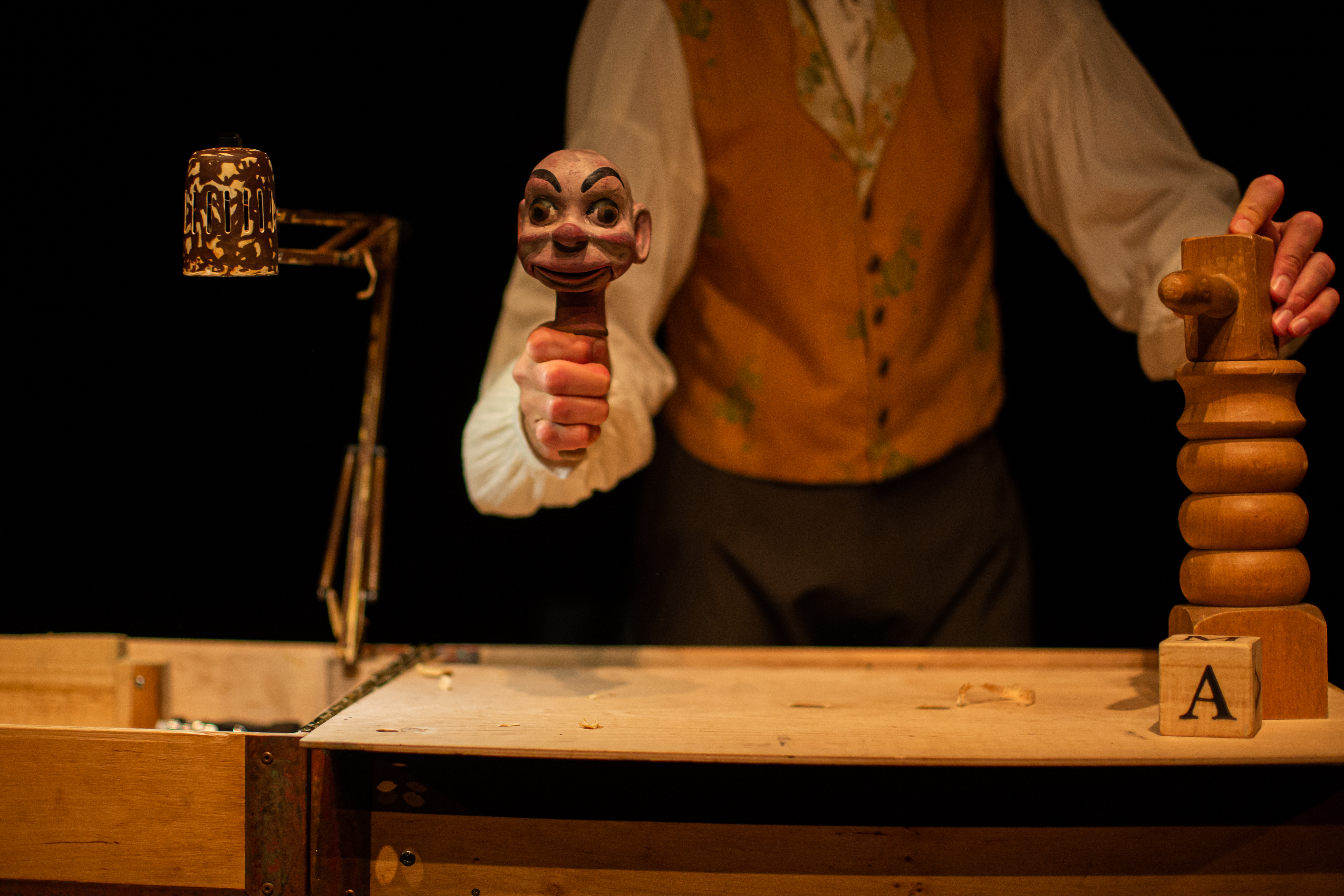Díjnyertes bábelőadás a Kisfaludy teremben - Így készült a Pinokkió
Maribor Puppet Theatre - Pinocchio / Pinokkió
Miha Bezeljak, színész
Honnan jött az ötlet az előadáshoz, mi volt a legfőbb inspiráció?
Pinokkió történetét vettük alapul, és igyekeztünk megvizsgálni és figyelembe venni azon időszak körülményeit, amikor a mű íródott, majd végiggondoltuk, hogyan rezonál mindez a jelenkorban, mi a tanulsága.
Az inspiráció forrása a Pinokkió történet volt, és a készítő ács műhelye, a 19. századból, azok az eszközök, amiket használt, és a hangok, amik a munkáját kísérték. Igyekeztünk annyi régi eszközt használni, amennyit csak tudtunk, és próbáltuk a történetben szereplő karakterekhez igazítani őket. Másrészről pedig egyszerű, és absztrakt fa formákat is használtunk.
A célközönség ismerete befolyásolja-e a művészi megnyilvánulás kifejezőeszköz rendszerét, mennyiben alkot másként a művész, ha tudja, hogy gyerekeknek alkot?
Pinokkió története valójában kortalan. Amikor kisgyermekeknek játszom eleinte kerülöm a szarkazmust, és egyszerűbb módon próbálom megnevettetni őket. A felnőttek intellektuálisabb szempontból közelítik meg a művet, de le tudom fegyverezni őket azzal, ha megnevettetem őket. Ezek miatt a kiszámíthatatlan tényezők miatt az előadás kezdete harminc százalékban improvizáció, azért, hogy meg tudjam teremteni a szükséges környezetet, bármilyen közönségről legyen is szó.
Miként zajlik a nézői reakciók vizsgálata, az új generáció szokásai; online jelenlétük miképpen befolyásolja a színház műfaját?
A legegyértelműbb visszajelzés a nevetés. Ha a közönség nevet, akkor tudom, hogy értik és élvezik az előadást. De ha nem nevetnek, az sem feltétlenül jelenti azt, hogy nem élvezik.
Néha előfordul, hogy van olyan felnőtt, aki a telefonját nyomkodja előadás közben. Ilyenkor igyekszem a többi száz emberre koncentrálni, akik élvezik az előadást. De az is előfordul, hogy inkább próbálom valahogy bevonni azt a személyt, az előadásba, aki elővette a telefonját. Jó dolog a modern technológia - de ahhoz, hogy győzzek vele szemben az átlagnál jobban kell küzdenem a néző figyelméért, és az előadásnak is még kiemelkedőbbnek kell lennie.
Hogyan változik a gyermek-és ifjúsági előadások alapanyaga? Mennyire van szó szimpla adaptációról, és mennyire vannak hatással az alkotói folyamatra az adott korosztály aktuális problémái?
Az érzéseknek őszintének kell lenni - a patronáló színészetnek nincs értelme. A színjátszás minősége ugyanaz marad. A tartalom összetettségét kell a közönséghez igazítani.
A mindennapi élet és a technológia növekvő térnyerése hatással van arra, hogy mennyire tudunk belemerülni az előadásba.
Hogyan alakítanak ki kapcsolatot az adott korosztállyal, mik lehetnek a fő kapcsolódási pontok?
Úgy tudok a legjobban kapcsolódni a közönséghez, hogyha megmutatom nekik, hogy én is pont annyira félek, és pont annyira törékeny vagyok, mint ők. Azt, hogy nekem is megvannak a saját problémáim. Ha valóban probléma merül fel az előadás közben, azt nem próbálom rejtegetni a közönség elől. Amikor pedig látják, hogy nekem is vannak problémáim, akárcsak nekik, akkor meg tudnak feledkezni magukról és velem azonosulnak, így képesek kikapcsolódni.

Miha Bezeljak, actor
Where is the idea of the show/play coming from? What was your main source of inspiration?
The sources of inspiration were the story of Pinocchio and the carpenters workshop from the 19th century with all the tools and sounds they make when the carpenter is working. We tried to use as much old tools as possible and tried to match them with the characters in thte story. On the other hand at we also use simple wooden blocks and abstract wooden forms.
Does the fact, that you know exactly who your target audience is, affect the way you express your art? How much difference does it make, to create something especially for children?
Pinocchio is actually for all ages. If I play for little ones I must avoid the sarcasm at the beginning and try to make them laugh in a more simple way. Adults look the show more in an intellectual way so making them laugh shuts down their intellectual guard. And beacuse all of that unpredictable factors the beginning is a thirty percent improvisation so that I can make the right climate for all type audience.
How do you examine feedback from the audience? How do the habits of the new generation, such as massive online presence affect the existence of the theaters?
The most clear feedback is laughter. When the audience laugh I know that they understand and enjoy. But if the do not laugh it does not mean that they are not enjoying it.
Sometimes there is an adult who uses the phone in the middle of the show . I try to focus ob the other hundred people which are enjoying the show. Or sometimes I try to incorporate the individual who is using the phone in the show. It is good to use technology - but to win the necessity of texting in the middle of the performance I need to be even more into getting their attention ant try to make the show even better.
How do the fundamentals of a play, created for children (and the youth) change? How much of the creation process is based on simple adaptation, and how much do the everyday lives, and the current problems of the youth affect it?
The feelings must be sincere - there is no place for patronized acting. The quality of acting stays the same. The complexity of the content must be adjusted.
The everyday lives and the increased consumption of technology does affect the ability to indulge into watching the performance.
How do you connect to children and young individuals? What are your main ways of connection?
I connect with the audience when I show them that i am also scared and frafgile as the are. That I have also my problems. And when a real problem happens in the performance I don’t hide it bit I show it to the audience. And when they see that I also have problems like them they will forget about themselves and they will identify with me forgetting a bit about their own lives.
Kiss Hanna










